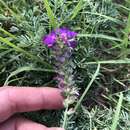Comprehensive Description
provided by North American Flora
Parosela lasianthera (A. Gray) A. Heller, Cat. N. Am PL ed. 2. 6. 1900.
Dalea pogonathera A. Gray, Bost. Jour. Nat. Hist. 6: !75. 1850. Not D. pogonathera A. Gray,
1849. Dalea lasianthera A. Gray, PI. Wright. 1: 47. 1852.
A perennial, with a woody root and short caudex; stems 1-3 dm. high, slender, glabrous, almost glandless; leaves 2-3.5 cm. long; stipules subulate, 1-2 mm. long; rachis margined, glabrous, slightly glandular-dotted; leaflets 7-13, linear-oblong or oblanceolate, rounded or retuse at the apex, 5-15 mm. long, glabrous, minutely glandular-dotted beneath; peduncles 3-5 cm. long; spikes comparatively dense, 3-6 cm. long; bracts broadly ovate, short-acuminate, bluish-green and conspicuously glandular-punctate on the back, somewhat scariousmargined; calyx-tube broadly turbinate, 3 mm. long, silky-villous and glandular-dotted; lobes plumose, with a triangular base and a short subulate tip, 2 mm. long; corolla purple; blade of the banner round-reniform, 4 mm. long, 5 mm. broad; wings and keel-petals inserted a little below the middle of the staminal tube, the blades strongly curved, those of the former 5 mm. long, those of the latter 6 mm. long; pod densely villous above.
Type locality: San Antonio, Texas. Distribution: Texas to Chihuahua and Tamaulipas.
- bibliographic citation
- Per Axel Rydberg. 1919. (ROSALES); FABACEAE; PSORALEAE. North American flora. vol 24(1). New York Botanical Garden, New York, NY
Physical Description
provided by USDA PLANTS text
Perennial, Herbs, Stems woody below, or from woody crown or caudex, Taproot present, Nodules pres ent, Stems erect or ascending, Stems or branches arching, spreading or decumbent, Stems less than 1 m tall, Plants gland-dotted or with gland-tipped hairs, Stems solid, Stems or young twigs glabrous or sparsely glabrate, Leaves alternate, Leaves petiolate, Stipules inconspicuous, absent, or caducous, Stipules setiform, subulate or acicular, Stipules deciduous, Stipules free, Leaves compound, Leaves odd pinnate, Leaf or leaflet margins entire, Leaflets opposite, Leaflets 5-9, Leaflets 10-many, Leaves glandular punctate or gland-dotted, Leaves glabrous or nearly so, Inflorescences spikes or spike-like, Inflorescence terminal, Bracts conspicuously present, Bracteoles present, Calyx 5-lobed, Calyx glabrous, Calyx hairy, Petals separate, Corolla papilionaceous, Petals clawed, Petals blue, lavander to purple, or violet, Banner petal narrow or oblanceolate, Banner petal ovoid or obovate, Wing petals narrow, oblanceolate to oblong, Wing tips obtuse or rounded, Keel tips obtuse or rounded, not beaked, Stamens 9-10, Stamens monadelphous, united below, Filaments glabrous, Style terete, Fruit a legume, Fruit unilocular, Fruit indehiscent, Fruit elongate, straight, Fruit oblong or ellipsoidal, Fruit enclosed in calyx, Fruit glabrous or glabrate, Fruit 1-seeded, Seeds reniform, Seeds cordiform, mit-shaped, notched at one end, Seed surface smooth, Seeds olive, brown, or black.
Dalea lasiathera: Brief Summary
provided by wikipedia EN
Dalea lasiathera, the purple prairieclover, is a plant from the Southwestern United States.
- license
- cc-by-sa-3.0
- copyright
- Wikipedia authors and editors

